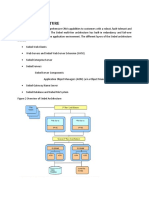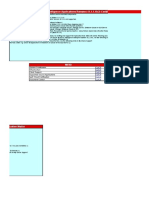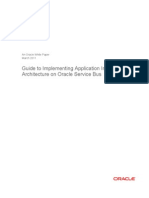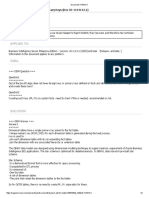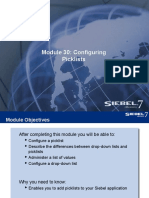Module 38: Understanding Siebel Event Models
Uploaded by
AkhamiePatrickOshiokeModule 38: Understanding Siebel Event Models
Uploaded by
AkhamiePatrickOshiokeEssentials (Siebel 7.
7)
Module 38: Understanding
Siebel Event Models
Module Objectives
After completing this module you will be able to:
Describe Siebel object instances and events
Explain Siebel Event Handling
List the processes that can be triggered by events
Why you need to know:
Understanding the Siebel Event model allows developers
to successfully extend the behavior of the standard Siebel
application
Module 38: Understanding Siebel Event Models 2 of 15
Siebel Object Model: Object Instances
When a user is using the Siebel application, instances of Siebel
objects are loaded into memory
View Business Object
(Account Detail (Account)
Contacts View)
Applet Business
(Account Entry Component
Applet) (Account)
Applet Business
(Account Contact Component
List Applet) (Contact)
Module 38: Understanding Siebel Event Models 3 of 15
Events and Event Handlers
An event is a user or system action that occurs while the Siebel
application is running
An event handler is a process in the Siebel application that
defines how the Siebel application responds to an event
The event: After creating a new record, the user steps off the
record
The event handler: The Siebel application commits the record to
the database
Module 38: Understanding Siebel Event Models 4 of 15
Object Instances and Events
Events occur on the object instances in memory
Example: After creating a new record, the user steps onto next
record in the applet
Applet
(Account List Applet) User steps off record Siebel Event Handler tells the
business component a new
record has been created
ChangeRecord Event fires
Business Component WriteRecord Event fires
Siebel Event Handler causes the
(Account) record to be written to the
database
Record is committed
to the database
Module 38: Understanding Siebel Event Models 5 of 15
Event Processing
When a selected event occurs, the Siebel execution engine:
Fires a pre-operation event
Executes the standard Siebel built-in event handler
Not visible or configurable by developers
Part of the C++ class specified for each object
Executes a post-operation event-handler process
Note: Not all exposed events are paired (have pre and post)
“pre” operation
Name prefixed
with “pre”
Siebel event
Siebel handler
Application Name not
prefixed with
“post” operation “post”
Module 38: Understanding Siebel Event Models 6 of 15
Pre-Operation Processing
The Siebel application can be configured to perform checks
before the standard Siebel event handler is executed and either:
Continue to the regular Siebel event handler, or
Cancel the regular Siebel event handler
“pre” cancel
operation
continue
Siebel Siebel event
Application handler
“post”
operation
Module 38: Understanding Siebel Event Models 7 of 15
Post-Operation Processing
The Siebel application can be configured to perform additional
processing that occurs after the standard Siebel event handler
has been executed
Processing is not executed if pre-operation cancels
“pre” cancel
operation
continue
Siebel Siebel event
Application handler
“post”
operation
Module 38: Understanding Siebel Event Models 8 of 15
Siebel Object Types with Exposed Events
Each object type is designed to handle certain processing
Application: Events occur at the application level
Example: Log in to application
Applet: Events occur at the applet level
Example: Drill down on hypertext link or click an applet button
Business Component: Events occur at the business component
level
Example: Update or insert a record
Module 38: Understanding Siebel Event Models 9 of 15
Runtime Events
The Object Manager monitors events occurring in the current
Siebel application instance
Select Site Map > Administration – Runtime Events > Events
A runtime event requires no compilation and can trigger:
Workflow processes
Personalization
Data validation
Business services
Module 38: Understanding Siebel Event Models 10 of 15
Siebel Workflow Processes
A workflow process is an ordered set of steps executed in
response to a defined set of conditions or an event
Covered in later modules
Workflow process
Event specified here Workflow step
Module 38: Understanding Siebel Event Models 11 of 15
Personalization
Siebel Personalization helps control content delivery and
enforce business rules
Allows the creation of rules that react to the user’s behavior at run
time
Example: When an eSales user adds printers to the shopping cart,
Personalization adds cables and ink cartridges to the Recommended
Products lists
Allows the creation of rules that determine which views, applets,
and records a given user will see
Example: The My Quotes applet will only appear in the home page if
the user chooses to add it to their home page layout
Module 38: Understanding Siebel Event Models 12 of 15
Data Validation
Siebel Data Validation allows field values or records to be
validated against business rules
Enables application administrators to create complex business
rules using a declarative interface
Define messages to be displayed to user if rule is violated
Validation history can be used to view log of rule violations
Module 38: Understanding Siebel Event Models 13 of 15
Business Services
A business service is a type of program that can be called within
the Siebel application
Encapsulates business logic
Business service types
Siebel-provided: Shipped with the application
Example: Outbound Communications Manager—allows you to send an
Custom: Business services created by Siebel developers
Example: Custom code to verify a credit card
Module 38: Understanding Siebel Event Models 14 of 15
Summary
This module showed you how to:
Describe Siebel object instances and events
Explain Siebel Event Handling
List the processes that can be triggered by events
Module 38: Understanding Siebel Event Models 15 of 15
You might also like
- Hourglass Workout Program by Luisagiuliet 276% (21)Hourglass Workout Program by Luisagiuliet 251 pages
- The Hold Me Tight Workbook - Dr. Sue Johnson100% (16)The Hold Me Tight Workbook - Dr. Sue Johnson187 pages
- Read People Like A Book by Patrick King-Edited62% (66)Read People Like A Book by Patrick King-Edited12 pages
- Livingood, Blake - Livingood Daily Your 21-Day Guide To Experience Real Health77% (13)Livingood, Blake - Livingood Daily Your 21-Day Guide To Experience Real Health260 pages
- COSMIC CONSCIOUSNESS OF HUMANITY - PROBLEMS OF NEW COSMOGONY (V.P.Kaznacheev,. Л. V. Trofimov.)94% (212)COSMIC CONSCIOUSNESS OF HUMANITY - PROBLEMS OF NEW COSMOGONY (V.P.Kaznacheev,. Л. V. Trofimov.)212 pages
- Donald Trump & Jeffrey Epstein Rape Lawsuit and Affidavits83% (1016)Donald Trump & Jeffrey Epstein Rape Lawsuit and Affidavits13 pages
- The 36 Questions That Lead To Love - The New York Times94% (34)The 36 Questions That Lead To Love - The New York Times3 pages
- The 36 Questions That Lead To Love - The New York Times95% (21)The 36 Questions That Lead To Love - The New York Times3 pages
- Jeffrey Epstein39s Little Black Book Unredacted PDF75% (12)Jeffrey Epstein39s Little Black Book Unredacted PDF95 pages
- The 4 Hour Workweek, Expanded and Updated by Timothy Ferriss - Excerpt23% (954)The 4 Hour Workweek, Expanded and Updated by Timothy Ferriss - Excerpt38 pages
- NOTICE: Support of BI Applications 11g With OBIEE 12.2.1 (12C)100% (1)NOTICE: Support of BI Applications 11g With OBIEE 12.2.1 (12C)25 pages
- BI Applications 11g Implementation Using ODINo ratings yetBI Applications 11g Implementation Using ODI4 pages
- ODI 11g Master and Work Repository Creation Steps - 1No ratings yetODI 11g Master and Work Repository Creation Steps - 120 pages
- OBIA 11.1.1.7.1 With ODI Step by Step Installation and ConfigurationNo ratings yetOBIA 11.1.1.7.1 With ODI Step by Step Installation and Configuration34 pages
- OBIEE 11g Analytics Using EMC Greenplum Database: - An Integration Guide For OBIEE 11g Windows UsersNo ratings yetOBIEE 11g Analytics Using EMC Greenplum Database: - An Integration Guide For OBIEE 11g Windows Users16 pages
- 11168-Tips To Optimize Oracle Business Intelligence Enterprise Edition Upgrade To 12c-Presentation With Notes - 551No ratings yet11168-Tips To Optimize Oracle Business Intelligence Enterprise Edition Upgrade To 12c-Presentation With Notes - 55119 pages
- Oracle BI Applications 11 1 1 9 2 Upgrade Guide PDFNo ratings yetOracle BI Applications 11 1 1 9 2 Upgrade Guide PDF92 pages
- Bi Apps Installation and Configuration On LinuxNo ratings yetBi Apps Installation and Configuration On Linux35 pages
- Business Intelligence Applications: Lab GuideNo ratings yetBusiness Intelligence Applications: Lab Guide105 pages
- Configuring ODI Studio and BI Client Tools.: Copy "Biee - Client - Install - X64.exe" File (From Linux)No ratings yetConfiguring ODI Studio and BI Client Tools.: Copy "Biee - Client - Install - X64.exe" File (From Linux)22 pages
- D S 030 Order Entry Application Setup CRP Sample100% (1)D S 030 Order Entry Application Setup CRP Sample276 pages
- Oracle Data Integrator 11g: Sunopsis in 2006No ratings yetOracle Data Integrator 11g: Sunopsis in 200613 pages
- Making The Move From Oracle Warehouse Builder To Oracle Data Integrator 12cNo ratings yetMaking The Move From Oracle Warehouse Builder To Oracle Data Integrator 12c34 pages
- OBIEE 12.2.1 External Subject Area Cache ConfigurationNo ratings yetOBIEE 12.2.1 External Subject Area Cache Configuration11 pages
- Oracle Utilities Software Development Kit V2.2.0 Installation GuideNo ratings yetOracle Utilities Software Development Kit V2.2.0 Installation Guide77 pages
- ConfiguringHighAvailability BIApplications11.1.1.8.1 Doc ID 1679319.1No ratings yetConfiguringHighAvailability BIApplications11.1.1.8.1 Doc ID 1679319.15 pages
- Oracle Middleware 12c In-Place Upgrade Procedure Project:: Tsoe - CcoeNo ratings yetOracle Middleware 12c In-Place Upgrade Procedure Project:: Tsoe - Ccoe47 pages
- Applies To:: OBIEE 12c: How To Enable Usage Tracking? (Doc ID 2366978.1)100% (1)Applies To:: OBIEE 12c: How To Enable Usage Tracking? (Doc ID 2366978.1)6 pages
- (OBIEE11g) Integrating Oracle Business Intelligence Applications With Oracle E-Business Suite - Oracle Bi SolutionsNo ratings yet(OBIEE11g) Integrating Oracle Business Intelligence Applications With Oracle E-Business Suite - Oracle Bi Solutions11 pages
- Oracle E-Business Suite Manufacturing & Supply Chain ManagementFrom EverandOracle E-Business Suite Manufacturing & Supply Chain ManagementNo ratings yet
- High-Performance Oracle: Proven Methods for Achieving Optimum Performance and AvailabilityFrom EverandHigh-Performance Oracle: Proven Methods for Achieving Optimum Performance and AvailabilityNo ratings yet
- How To Enable Detailed Logging For Tracing and Troubleshooting Siebel EAI and UCM Issues (Doc ID 1929084.2)No ratings yetHow To Enable Detailed Logging For Tracing and Troubleshooting Siebel EAI and UCM Issues (Doc ID 1929084.2)2 pages
- 50ESS - Migrating From Development To TestNo ratings yet50ESS - Migrating From Development To Test25 pages
- Module 42: Deploying Workflow ProcessesNo ratings yetModule 42: Deploying Workflow Processes23 pages
- 51ESS - Using Siebel Remote To Support Mobile ClientsNo ratings yet51ESS - Using Siebel Remote To Support Mobile Clients33 pages
- 37ESS - Setting Enterprise Integration Manager OptionsNo ratings yet37ESS - Setting Enterprise Integration Manager Options15 pages
- 47ESS - Assignment Manager ConfigurationNo ratings yet47ESS - Assignment Manager Configuration26 pages
- Module 44: Understanding Interactive and Long-Running FlowsNo ratings yetModule 44: Understanding Interactive and Long-Running Flows17 pages
- 39ESS - Best Practices For Siebel ScriptingNo ratings yet39ESS - Best Practices For Siebel Scripting24 pages
- 33ESS - Exploring Integration StrategiesNo ratings yet33ESS - Exploring Integration Strategies20 pages
- Module 31: Configuring Multi-Value GroupsNo ratings yetModule 31: Configuring Multi-Value Groups24 pages
- 23ESS - Editing and Compiling Object DefinitionsNo ratings yet23ESS - Editing and Compiling Object Definitions26 pages
- 29ESS - Creating Business Components and FieldsNo ratings yet29ESS - Creating Business Components and Fields18 pages
- 28ESS - Configuring Business Components and FieldsNo ratings yet28ESS - Configuring Business Components and Fields27 pages
- 26ESS - Configuring Applications Screens and ViewsNo ratings yet26ESS - Configuring Applications Screens and Views31 pages
- Module 14: Controlling Access To Master DataNo ratings yetModule 14: Controlling Access To Master Data27 pages
- 24ESS - Understanding The Physical User InterfaceNo ratings yet24ESS - Understanding The Physical User Interface17 pages
- 18ESS - Understanding Business ComponentsNo ratings yet18ESS - Understanding Business Components16 pages
- Livingood, Blake - Livingood Daily Your 21-Day Guide To Experience Real HealthLivingood, Blake - Livingood Daily Your 21-Day Guide To Experience Real Health
- COSMIC CONSCIOUSNESS OF HUMANITY - PROBLEMS OF NEW COSMOGONY (V.P.Kaznacheev,. Л. V. Trofimov.)COSMIC CONSCIOUSNESS OF HUMANITY - PROBLEMS OF NEW COSMOGONY (V.P.Kaznacheev,. Л. V. Trofimov.)
- Donald Trump & Jeffrey Epstein Rape Lawsuit and AffidavitsDonald Trump & Jeffrey Epstein Rape Lawsuit and Affidavits
- The 36 Questions That Lead To Love - The New York TimesThe 36 Questions That Lead To Love - The New York Times
- The 36 Questions That Lead To Love - The New York TimesThe 36 Questions That Lead To Love - The New York Times
- Jeffrey Epstein39s Little Black Book Unredacted PDFJeffrey Epstein39s Little Black Book Unredacted PDF
- The 4 Hour Workweek, Expanded and Updated by Timothy Ferriss - ExcerptThe 4 Hour Workweek, Expanded and Updated by Timothy Ferriss - Excerpt
- NOTICE: Support of BI Applications 11g With OBIEE 12.2.1 (12C)NOTICE: Support of BI Applications 11g With OBIEE 12.2.1 (12C)
- ODI 11g Master and Work Repository Creation Steps - 1ODI 11g Master and Work Repository Creation Steps - 1
- OBIA 11.1.1.7.1 With ODI Step by Step Installation and ConfigurationOBIA 11.1.1.7.1 With ODI Step by Step Installation and Configuration
- OBIEE 11g Analytics Using EMC Greenplum Database: - An Integration Guide For OBIEE 11g Windows UsersOBIEE 11g Analytics Using EMC Greenplum Database: - An Integration Guide For OBIEE 11g Windows Users
- 11168-Tips To Optimize Oracle Business Intelligence Enterprise Edition Upgrade To 12c-Presentation With Notes - 55111168-Tips To Optimize Oracle Business Intelligence Enterprise Edition Upgrade To 12c-Presentation With Notes - 551
- Oracle BI Applications 11 1 1 9 2 Upgrade Guide PDFOracle BI Applications 11 1 1 9 2 Upgrade Guide PDF
- Configuring ODI Studio and BI Client Tools.: Copy "Biee - Client - Install - X64.exe" File (From Linux)Configuring ODI Studio and BI Client Tools.: Copy "Biee - Client - Install - X64.exe" File (From Linux)
- Making The Move From Oracle Warehouse Builder To Oracle Data Integrator 12cMaking The Move From Oracle Warehouse Builder To Oracle Data Integrator 12c
- OBIEE 12.2.1 External Subject Area Cache ConfigurationOBIEE 12.2.1 External Subject Area Cache Configuration
- Oracle Utilities Software Development Kit V2.2.0 Installation GuideOracle Utilities Software Development Kit V2.2.0 Installation Guide
- ConfiguringHighAvailability BIApplications11.1.1.8.1 Doc ID 1679319.1ConfiguringHighAvailability BIApplications11.1.1.8.1 Doc ID 1679319.1
- Oracle Middleware 12c In-Place Upgrade Procedure Project:: Tsoe - CcoeOracle Middleware 12c In-Place Upgrade Procedure Project:: Tsoe - Ccoe
- Applies To:: OBIEE 12c: How To Enable Usage Tracking? (Doc ID 2366978.1)Applies To:: OBIEE 12c: How To Enable Usage Tracking? (Doc ID 2366978.1)
- (OBIEE11g) Integrating Oracle Business Intelligence Applications With Oracle E-Business Suite - Oracle Bi Solutions(OBIEE11g) Integrating Oracle Business Intelligence Applications With Oracle E-Business Suite - Oracle Bi Solutions
- Oracle E-Business Suite Manufacturing & Supply Chain ManagementFrom EverandOracle E-Business Suite Manufacturing & Supply Chain Management
- High-Performance Oracle: Proven Methods for Achieving Optimum Performance and AvailabilityFrom EverandHigh-Performance Oracle: Proven Methods for Achieving Optimum Performance and Availability
- How To Enable Detailed Logging For Tracing and Troubleshooting Siebel EAI and UCM Issues (Doc ID 1929084.2)How To Enable Detailed Logging For Tracing and Troubleshooting Siebel EAI and UCM Issues (Doc ID 1929084.2)
- 51ESS - Using Siebel Remote To Support Mobile Clients51ESS - Using Siebel Remote To Support Mobile Clients
- 37ESS - Setting Enterprise Integration Manager Options37ESS - Setting Enterprise Integration Manager Options
- Module 44: Understanding Interactive and Long-Running FlowsModule 44: Understanding Interactive and Long-Running Flows
- 28ESS - Configuring Business Components and Fields28ESS - Configuring Business Components and Fields
- 26ESS - Configuring Applications Screens and Views26ESS - Configuring Applications Screens and Views























































